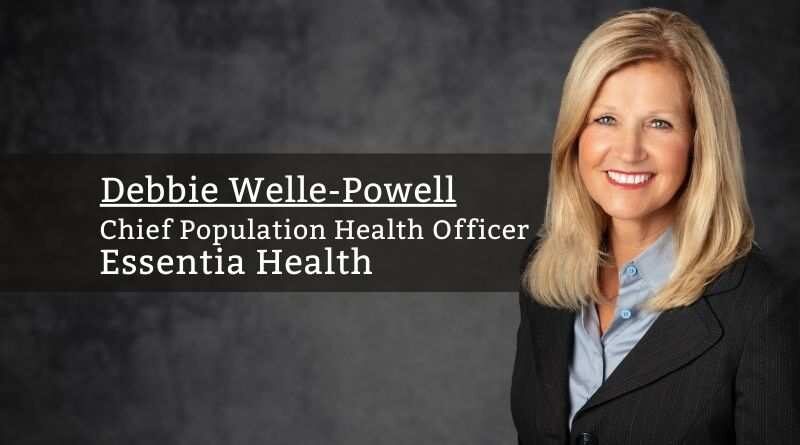Essentia’s Population Health Strategy for its community
By Debbie Welle-Powell, Chief Population Health Officer, Essentia Health
Essentia Health’s Population Health Strategy begins with our Mission of “We are called to make a Health Difference in People’s Lives”.
This lays the groundwork for advancing three fundamental pillars in population health: risk-based payer contracting, expanding innovative chronic care models and screening for social needs and social determinants of health (SDOH) for all patients, whether in our clinics or our communities.
Essentia Health has been on a journey for several years to move from a payment system that rewards us based on the volume of services provided to one based on the value of those services. Essentia holds thirteen Total Cost of Care payer agreements totaling 190,000 at-risk lives in Medicare, Medicaid, and Commercial populations. Approximately 42% of our Fee-For-Service revenue flows through these agreements. Negotiating value-based, risk contracts is a key driver to our success as an ACO and Integrated Health System.
Essentia is improving the quality of care, lowering the costs of care, and engaging our patients with their care while extending our work in our communities.
Our Five-Year Population Health strategy calls for growth in ACO lives with annual improvements and reductions in bending the costs of care across all populations.
Our Approach
A critical success factor in improving the health of our patients is to identify those patients who need care the most. This is done by integrating claims data from the payers with EPIC’s EMR. This approach allows us to risk-stratify the populations and focus on high-needs patients, rising-risk patients and patients who need basic wellness and prevention care (e.g., annual visits), or preventive care measures such as health screenings and flu shots. In addition, any care provided by Essentia is captured nightly to inform outreach through our care coordination platform, Healthy Planet.
Our work focuses on collaborating and connecting with the clinical practice. In fact, we view ourselves as an extension of the clinical practice. Care coordinators develop care plans and coordinate transitions of care with physicians, hospitals, skilled nursing facilities, specialty providers, ambulatory centers, and community resources. We use standard workflow to evaluate patient risk and connect the evidence-based protocols to better outcomes.
Prior to COVID, we offered limited retail e-Visits and Remote patient monitoring (RPM) only to high acuity Chronic Heart Failure patients. When the Pandemic hit, we fast-tracked the adoption of digital technology. With the technology platform in place (built), we were able to move quickly to direct-to-consumer services that kept our patients safely in their homes. Today our direct-to-consumer (DTC) digital programing includes on-demand Video Visits, retail e-Visits, RPM, and our CMS Hospital at Home Waiver program.
This model of care is generating higher patient satisfaction scores, showing we are truly improving the patients’ experience. Recently, we expanded RPM to chronic conditions such include as cirrhosis, diabetes, oncology, and heart failure.
Value-based Results
Overall, Essentia is improving the quality of care, lowering the costs of care, and engaging our patients with their care while extending our work in our communities.
In 2020, we reduced total costs of care by 3.50% after accounting for trend. Our successes came from understanding the unique opportunities in each population and using data and technology to improve the care model. With well over 650,000 telehealth visits since the pandemic and by expanding RPM program, conservatively speaking, our work generated savings of approximately $2.5M across Medicare, Medicaid, and Commercial populations.
Another measure of engagement is tracking the utilization of patients using MyChart. Today, 86% of all ACO patients are actively using myChart for prescription refills, lab results, scheduling appointments, reference guides, advance care planning and messaging to the provider.
Community Health
We recognize the importance of working collaboratively with community partners. We engage with community members, organizations, and local public health to problem-solve solutions in areas identified through the Community Health Needs Assessment (CHNA). Community Health Workers and Community Relations compliments this work as well as the work of operations and other areas of our organization, by developing deepened connections with key stakeholders and ensuring we’re responsive and accountable to uplift our communities.
Our community-giving strategies are moving from annual plans to longer-term impact on the Social Determinants and are focused on the health and vitality of our neighborhoods through housing, child-care, and mental health training, etc. Shorter-term efforts focus on food banks, farmers’ markets, and transportation. Our community investments are designed to improve health, lessen inequities, improve access to health care, and strengthen the fabric of our communities. Our approach is centrally supported and locally delivered.
Impacting SDOH
While working with a patient to address an immediate social need can be impactful for that individual, addressing the complexity of SDOH one patient at a time is unlike to make the lasting, systemic change needed for making substantial improvements in the root causes of health disparities. In addition to the direct service provided for patients through this program, Essentia Health is also collecting valuable data that can support system change at the community level.
By working across multiple levels of impact (individual, organizational, community), Essentia Health is analyzing the broader context around poverty and inequity in the community. The focus is on identifying root causes, resource gaps, improving communication, and coordination among services/resource providers.
Technology innovation was identified as a necessary strategy to improve performance, particularly for unmet social needs. To generate a baseline of needed information, a social needs questionnaire in MyChart (patient EHR portal) was developed and automatically assigned to all patients prior to their visit. It is also included in the rooming process for patients who are not active on MyChart. The questionnaire has been sent with 1 million encounters and completed 420,330 times (46% response rate).To meet patients’ social needs identified through this screening, we employ community health workers to connect with patients and recently launched a web-based tool which supports patient referrals to community social service agencies.
In Summary
It is through the support of leadership, our innovative risk-based relationships with payers, digitally expanding chronic care models and integrating the social needs of our patients into their clinical care plans has allowed us to take a more compressive and holistically view of improving the health of our patients and communities which we are privileged to serve.



